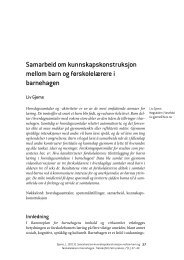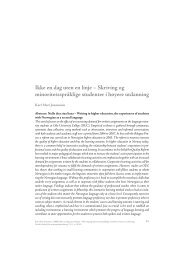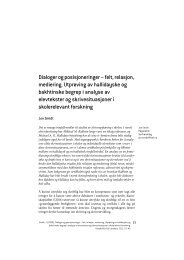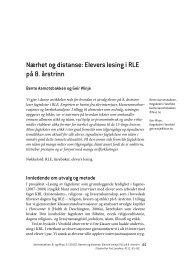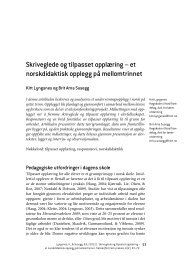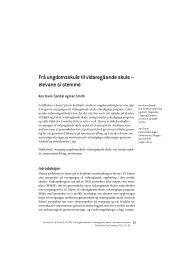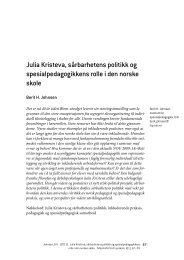AN ESSAY ON SPIRITUALITY OF HOMO LUDENS URBANUS
AN ESSAY ON SPIRITUALITY OF HOMO LUDENS URBANUS
AN ESSAY ON SPIRITUALITY OF HOMO LUDENS URBANUS
- No tags were found...
Create successful ePaper yourself
Turn your PDF publications into a flip-book with our unique Google optimized e-Paper software.
Pasi Mäenpää: An essay on spirituality of homo ludens urbanusurban generation grew up and started a cultural upheaval with urbanity, aesthetics andconsumption as their main themes (Mäenpää 2005).The main urban happening was the Night of Arts since 1987. The Night of Arts is anevening when most of the cultural institutions of the city, such as libraries, museums, theatres,bookstores and art galleries, keep their doors open offering special presentationsand discussions without admission. In Helsinki it has become an institutionalised annualurban event which finishes the summer period that the first of May has opened. It is notexaggeration to say that the Night of Arts has become a model for urbanity in Finland.My study (Mäenpää 2005) of the Night of Arts was crystallised in an expression an intervieweeexplained its characteristics: «It’s so free. The crowd in a way enables you to goplaces [like art galleries] where you somehow cannot otherwise go. But now you are partof a flock.»What is the origin of the sense of freedom these urban events promote? It is based onthe specific interaction order of the modern city life prevailed by anonymity. In streetsand squares and shopping malls where lots of people move about, everyone is seen byeveryone but everyone also lets everyone be. It is the simultaneous liveliness of theoutside and the tranquillity of the inside of oneself which make anonymous public encountersa sphere of freedom (Simmel 1964b). They offer a place to look around in yourown thoughts without, so to say, being caught of what you think.The key to the success of both The Night of Arts and St. Thomas Mass is in the powerof urban crowd to free people socially to encounter something new. In crowd you areallowed to take part on institutions like art performance or religious ceremony feelingfree to go first in and then out without being necessarily an enthusiast of art or Jesus. Thisfreedom is given by urbanity itself, and as an idea of ‘lowering of the threshold’ it hasbeen utilised – both physically and symbolically – by museums and other cultural institutionsrecently, as well.Freedom of oneself to become oneselfLet us continue with the idea of not having to be something or someone, of being anonymousamongst others of the same kind. Being no-one carries also potential to besomeone. Let us go back to open doors and the possibility to choose. Gerhard Schulze(1992) has described our Erlebnisgesellschaft as a world of choosing. However,Schulze says also, that choosing does not aim so much to possessing but to being.Erlebnis, or inner experience in English, requires installing oneself to some part or rolein life like having a role in a theatre play. This is the theatrum mundi effect that urbanlife carries and which comes true in the consumption of material or (merely) symbolicthings, like art works or religious thoughts. The playfulness of consumption involvesvirtual role-playing in one’s own mind (Campbell 1987). And this is what urban publicspace provides as a stage-like theatrum mundi.The anonymity of the urban crowd detaches one from one’s own personality. Thissituational impersonality then enables one to attach to something new, whether it was fashionablesun glasses, arte povera or the idea of loving your neighbour. Department store,7



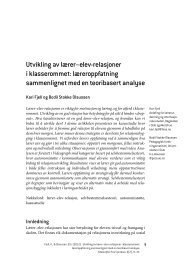
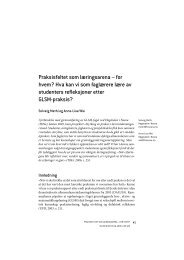
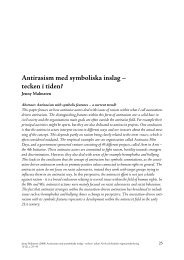
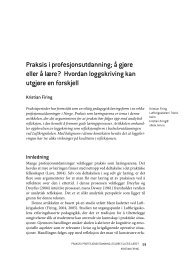
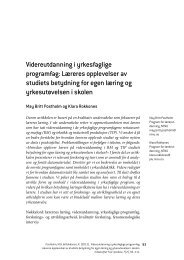
![Hvordan skal jeg […] utvikle meg selv? - Tapir akademisk forlag](https://img.yumpu.com/47976067/1/184x260/hvordan-skal-jeg-utvikle-meg-selv-tapir-akademisk-forlag.jpg?quality=85)
